

The practice of soccer for the adequate use of free time in adolescents (Original)
La práctica de fútbol para el uso adecuado del tiempo libre en adolecentes (Original)
Olimpia, vol.. 19, no. 1, 2022
Universidad de Granma


Artículos científicos
Received: 10 October 2021
Accepted: 10 January 2022

Abstract: The search for alternatives to meet the needs of adolescents is today a priority for society, occupying free time is undoubtedly a viable alternative framed in their motivations and interest, such as the practice of soccer, organized in deep-rooted recreational sports activities in their traditions. The objective of this experience is to determine the impact of the recreational sports activities program towards the practice of soccer as a means in the adequate use of free time in adolescents between 10 and 14 years of age in the Las Jacuatas sector of the Montecristi canton. Theoretical and empirical methods were used, within them, the direct observation guide, surveys to adolescents, questionnaire to representatives, to determine the free time spaces, motivations, availability and family support for adolescents. With the application of the program of recreational sports activities directed towards the practice of soccer of the adolescents of the Jacuatas sector of the Montecristi canton, the result was the use of their free time, an increase in their technical, tactical, and regulatory knowledge, greater sociability with peers, family support and acceptance.
Keywords: adolescents, soccer, program, free time.
Resumen: La búsqueda de alternativas para atender las necesidades de los adolescentes constituye hoy en día una prioridad para la sociedad, ocupar el tiempo libre es sin duda una alternativa viable enmarcado en sus motivaciones e interés como es la práctica de fútbol, organizada en actividades deportivas recreativas arraigada en sus tradiciones. Esta experiencia tiene como objetivo determinar el impacto del programa de actividades deportivas recreativas hacia la práctica del fútbol como medio en el uso adecuado del tiempo libre en los adolescentes entre 10 y 14 años del sector Las Jacuatas del cantón Montecristi. Se utilizaron los métodos teóricos y empíricos, dentro de ellos, la guía de observación directa, encuestas a los adolescentes, cuestionario a los representantes, para determinar los espacios de tiempo libre, motivaciones, disponibilidad y apoyo familiar a los adolescentes. Con la aplicación del programa de actividades deportivas recreativas dirigidas hacia la práctica de fútbol de los adolescentes del sector las Jacuatas del cantón Montecristi, se obtuvo como resultado el aprovechamiento de su tiempo libre, incremento de sus conocimientos técnico, táctico, reglamentario, mayor sociabilidad con los compañeros, apoyo y aceptación familiar.
Palabras clave: adolescentes, fútbol, programa, tiempo libre.
Introduction
When reference is made to free time, one automatically thinks of having a space to rest
When reference is made to free time, one automatically thinks of having a space to rest, these words come from two Latin words ''tempus'' which means time or moment and ''libero'' which means free. Therefore, it is all that time that a person has to perform activities of their liking that are not work-related.
In this regard, Oropesa (2014) argues that free time "presents a voluntary character, therefore, it is not imposed; it incorporates a clear component of fun, includes activities that are desired, liked to do and that make us feel good; it is linked to the personal sphere" (p. 236).
For his part, Waichman (2004) argues that "free time will no longer be unoccupied time or time freed from obligations, but a time of freedom for freedom as the transformation of man" (p. 141). In other words, the person has the power to freely choose any activity that pleases him/her, where he/she feels at ease and generates enjoyment.
On the other hand, the World Health Organization defines "adolescence as the period of human growth and development that occurs after childhood and before adulthood, between the ages of 10 and 19." It is evident that this stage is times of preparation for adulthood, during which several experiences occur that, contribute to its development.
Currently, the use of free time in adolescents has aroused the interest of many researchers due to the various activities they carry out during this free time, which do not contribute any benefit to their health; in other words, this time has not been properly used by adolescents due to social networks, television and other occupations; in addition, at this stage there is also a considerable risk in the social context, as it can have a determining influence on their lives. Nuviala et al (2003 as cited in Puente et. al., 2011) mention that:
"Adolescents' free time is increasing at the same rate as the rest of society. There is a tendency to group the school day together or to create an intensive school day, with a consequent increase in free time. It is in this time that society must intervene to facilitate the child's occupation in activities that favor his or her integral development". (p. 6)
The idea of making the most of free time has different conceptions, understood as productive use in the development of activities that are productive for the individual's development; consequently, it is important for adolescents to make proper use of their free time, which may include sports activities aimed at training the individual to make his or her free time more enriching, or it may be directed at some educational objective.Chin, (2018)
Ponseti et a. (1998) mention that "the practice of sports is one of the leisure activities preferred by the population, however, athletes do not form a homogeneous group, since there are important differences depending on gender and different psychosocial factors" (p. 262). (p. 262). Sport fully interferes in daily life and in the processes of socialization, determining a good part of the free time which constitutes a reference in the construction of identity, it is one of the most popular phenomena of our time that is largely embraced by children, adolescents and adults, its work lies in providing an influence on the behavior of the human being, in the development of discipline, in the expression of values, in the production of sensations; It intervenes in the daily life of man, in the processes of socialization; therefore, it is constituted as one of the main starting points in the use of free time.
Ponseti, Gili, M., Palou, y Borrás, (1998); Muñiz Rodríguez &Barrueto González (2019) state that participation by young people in the organized practice of recreational sports activities favors their self-formation, since they manage to develop in the participation of different recreational sports activities and it is here where they freely externalize their desires in the practice of different recreational sports; it also contributes in the expansion of knowledge and experiences that are marked in their bodies and minds. (p. 151).
Soccer is a modern sport that is played as a whole, where two teams face each other, with the objective of scoring goals in their favor and prevent their team from being scored against; it also has as a regulating entity the referees who are the judges that enforce the rules that govern this sport.
In this sport several people interact, each one has a common goal, which is determined in achieving a triumph from the implementation of the different rules that soccer has. For Hernández Moreno (1993, as cited in Tapia and Hernández, 2010), "soccer is a collaborative team sport of opposition, played in a 'semi-wild' and common space, with simultaneous participation". From the point of view of this author we can mention that within soccer there is a collective participation between two teams that dispute a ball and a territory to dispute a certain objective as each group desires.
After the above, it is appropriate to express that being able to practice the sport of soccer generates identification with this sport; besides accepting the rules, the rivals and the results are part of the game, it allows acquiring identification with the sport, besides enjoying every action and moment that occurs in the game.
The importance of the sport of soccer brings benefits for those who practice it, practicing a sport in adolescence contributes to the maintenance of a good general state of health, avoiding the risk of obesity, promoting growth, preventing diseases, fortifying bones and muscles; it also relieves stress, combating possible crises of anxiety or depression, improving sleep and mental health; it also helps to improve school performance and social interaction, and serves to offset the negative effects that come from other activities.Mateo, (2014) y Razo, (2017).
Therefore, it can be said that the practice of soccer is an option that adolescents have to adequately use their free time since it compensates for the various activities or situations that may be harmful to their physical and emotional integrity; for this reason, an interest in the practice of sports activities should be provoked, which can bring about a positive change in their lives, thus taking advantage of their free time in productive activities that favor their health by creating sports habits that form and develop their physical, technical and tactical abilities.
The objective of this research is to determine the impact of the recreational sports activities program on the practice of soccer during the adequate use of free time of adolescents between 10 and 14 years of age in the Jacanas sector of the Monetarist canton, Ecuador.
Population and sample
For the study we considered a population of different strata, 30 adolescents between 10 and 14 years of age from the Las Jacanas sector of the Monetarist canton. For a better management and reliability of the information, we have considered working with the entire universe, for which the following criteria were taken into account.
Adolescents with voluntary participation.
Motivation and interest in practicing this sport.
Support from parents and family.
Attention to special educational needs
It is a program of social participation and orientation towards sports.
Adequate use of adolescents' free time.
This research has a mixed approach integrating qualitative and quantitative aspects through research instruments, which allow analyzing the problematic situation, where the variables are articulated to subsequently develop the proposed solution, as it is intended to investigate the impact of soccer on the proper use of leisure time of adolescents aged 10 to 14 years in the Jacanas sector of the Monetarist canton.
Bibliographic research was conducted in electronic books on the internet, similar theses on the subject of sports activities in the proper use of leisure time, as well as in books and magazines with these themes. The field research was carried out in the jacanas sector of the Monetarist Canton. The quasi-experimental research was applied in the realization of the program of activities of the sport of soccer with adolescents between 10 and 14 years of age in the sector. In the descriptive research, the causes and consequences of the problem studied are detailed, with regard to the practice of sports and the adequate use of free time that promotes the integral development of adolescents.
Research techniques and instruments
For the development of the research it was necessary to use theoretical, empirical and mathematical statistical methods, which are described below:
Theoretical level
Analytical-synthetic: it allowed the study of the relationships between the practice of soccer with adolescents and the adequate use of free time in order to establish qualities, ideas, regularities both in the theoretical systematization and in the interpretation of the results of the diagnosis and planning of the program of recreational sports activities in the practice of soccer for the adequate use of free time.
Inductive-deductive: it was used with the purpose of including the study of particular situations, cases, of the programs for the practice of soccer in adolescents in order to determine its particularities and generalities.
Empirical level
The techniques to be used for the collection of information are: documentary and field.
The instruments are: three surveys to adolescents between 10 and 14 years old and a questionnaire to parents of the jacanas sector of the Monetarist canton in the province of Manabí.
Revision of documents: soccer practice programs for adolescents in Ecuador were analyzed.
Mathematical and statistical level
Descriptive statistics were used for the analysis of the results obtained in the research, by means of frequency distribution tables of the instruments applied for the verification of the problem and assessment of the applicability of the program of activities by means of percentage analysis.
Inferential statistics were also used, particularly McNamara’s nonparametric test. In order to know if the transformations that occurred as a result of the research were significant or not.
Analysis of the results
For the realization of this program of sports activities in the practice of soccer, the respective analysis of the budget of free time was carried out, in which the time in which the activities are carried out and the availability of time they have were registered, reflecting that in the day they have 4 hours of free time in two moments, 2 hours in the morning and 2 hours in the afternoon.
For the implementation of the program, a consensus was reached with the surveyed adolescents to put it into practice in the afternoon free hours, which correspond to the hours between 16:00 and 17:30.
The survey of tastes and preferences were analyzed for the design of the sports activities program, which consists of four phases that are linked and complement each other, the actions of the sports activities program respond to the verification of the proposed objective.
Example of the functioning of the program of recreational sports activities in the practice of soccer for the adequate use of free time.
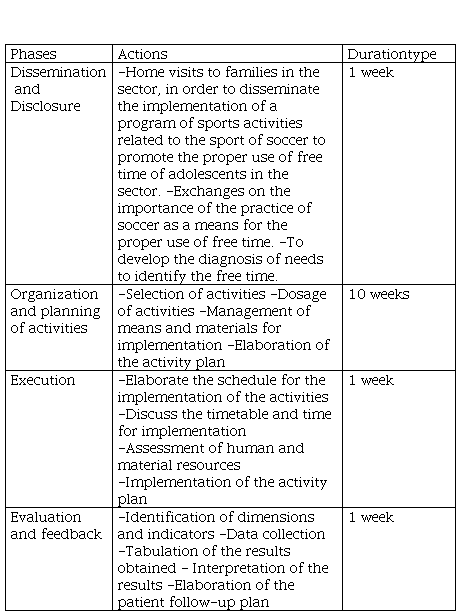
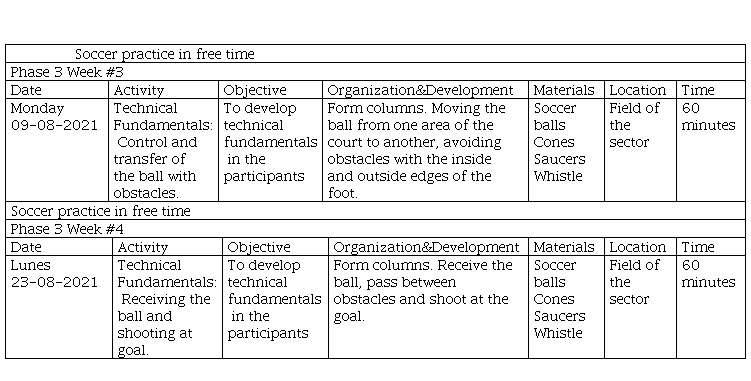
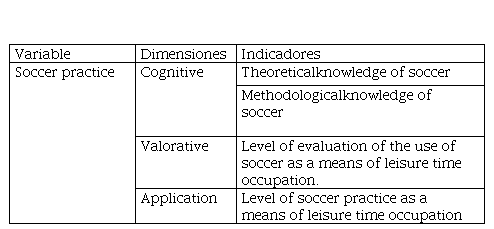
The interpretation of the results obtained before and after applying the program of activities is shown below:
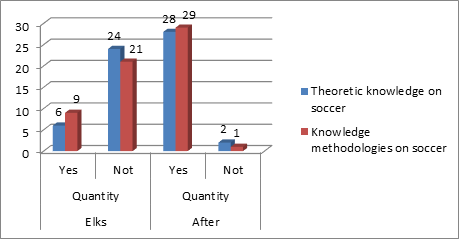
As shown in graph 1, before applying the program of activities designed, there were a large number of adolescents who showed difficulties in the theoretical knowledge of soccer indicator, since most of the subjects investigated stated that they did not have any, as reflected in the fact that 24, for 80% of the total sample, showed no knowledge. Only a minority showed knowledge 6 for 20%. However, once the program was applied, a positive transformation was evidenced in the sample studied, since most of the adolescents showed theoretical knowledge of soccer (28 for 93.3). According to their criteria, this knowledge was learned during the research.
In the methodological knowledge indicator, similar results were shown, since before applying the program, most of the sample under study did not know them (9 for 30%). On the other hand, after applying the program, an increase was evidenced, since the majority of the subjects investigated (29 for 96.6%) did know them.
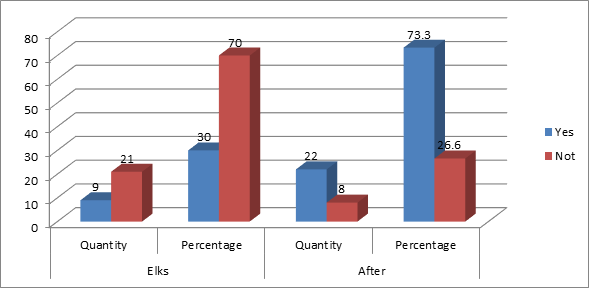
When analyzing the results of Graph 2, it can be seen that there is an important difference between before and after. The majority of the adolescents changed from no to yes. This shows that their appreciation of the importance of soccer as a means of occupying their free time is remarkable. Therefore, the effectiveness of the program in this dimension is evident.
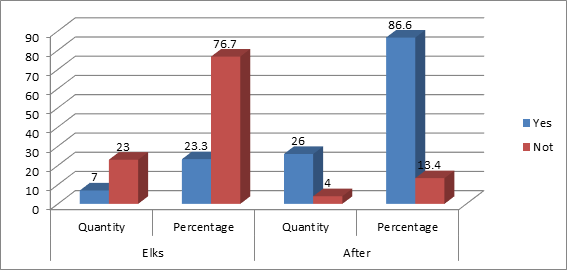
The results of graph 3 corroborate that, as in the previous graphs, there is a tendency to increase the yes option in the survey. Thus, it can be seen that the results are favorable to the program of activities developed.
Validation of the study
To determine if the difference between before and after the application of the recreational sports activities program for the practice of soccer during the adequate use of free time of adolescents between 10 and 14 years of age in the Jacuatas sector of the Montecristi canton was significant, McNemar's nonparametric test was applied. After being processed with SSPS for Windows version 20.0. It shows that in the three dimensions evaluated there was a significant difference between before and after, since its p is 0.00. This confirms the validity of the results obtained.
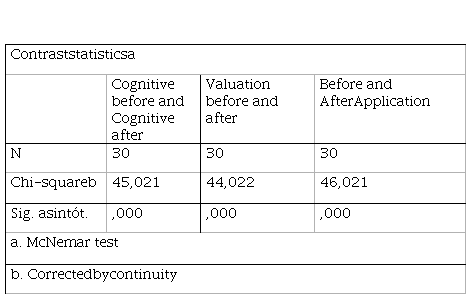
Conclusions
The implementation of this program of recreational sports activities for the practice of soccer made it possible to encourage the habit of playing this sport in their free time and thus raise awareness of the importance of doing sports activities in their free time for the benefit of their health.
The results obtained in the diagnosis made it possible to know that the young people of the sector were using their free time in a wrong way, doing activities that were not beneficial for their wellbeing.
The development of this program of activities in the sport of soccer made it possible to increase the level of knowledge of the adolescents regarding the technical, tactical and regulatory aspects so important in the practice of the sport of soccer.
The effectiveness of the application of this program was proven by the level of acceptance and satisfaction obtained through the gradual increase in the attendance of the adolescents of the sector, which grew weekly due to the interest caused by the practice of this sport.
Bibliographic references.
Chin Soong, SA (2018) physical recreation geared towards sustainable development in the protected area, nariva swamp, trinidad and tobago. (Unpublished doctoral dissertation).University of Sciences of Physical Culture and Sport, Havana, Cuba 198 p.
Hernández, J. (1993). A methodology of game observation in soccer.Quantification of pause and participation time.Science and technique of soccer. (pp. 181-191). Madrid: Gymnos.
Mateo Sánchez, J.L. (2014). Free time, leisure and recreation and their epistemologicalperspectives. EFDeportes.com, Revista Digital. Buenos Aires - Year 19 - (Nº 193) - June 2014. http://www.efdeportes.com
Muñiz, B., &Barrueto González, J. (2019). Community sports-recreational activities to improve lifestyle in young people.Lecturas: Educación Física Y Deportes, 23(248), 149-163. Retrievedfrom https://www.efdeportes.com/efdeportes/index.php/EFDeportes/article/view/1017
Nuviala, A., Ruíz, F., & García, M. (2003). Leisure time, leisure and physical activity in adolescents.The influence of parents.:http://scholar.google.com.mx/scholar?q=definicion+of+leisure+time&hl=en&lr=, retrieved November 13, 2009.
World Health Organization (2020) Adolescence and growth (November 26, 2020). https://www.who.int/es/news-room/fact-sheets/detail/physical-activity.
Ponseti, F., Gili, M., Palou, P. and Borrás, P. (1998). Interests, motives and attitudes towards sport in adolescents: differences according to the level of practice. Journal of Sport Psychology 1998. Vol. 7, no. 2, pp. 259-274 ISSN: 1132-239x. Spanish Federation of Sports Psychology Associations University of the Balearic Islands.
Razo, AA (2017) Recreational activities and leisure time of adolescents aged 14 to 17 years in the hamlet San Luis, canton Tisaleo. (Unpublished undergraduate thesis), Universidad técnica de Ambato, Ecuador.
Tapia, A., and Hernández, A. (September, 2010) Soccer: concept and research. Revista Digital Efdeportes, Buenos Aires, Year 15 - Nº 148 https://www.efdeportes.com/efd148/futbol-concepto-e-investigacion.htm.
Waichman, P. (2004). Tiempo libre y recreación un desafío pedagógico. Buenos Aires. Ediciones PW.

